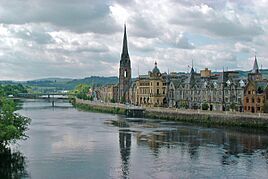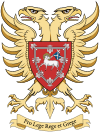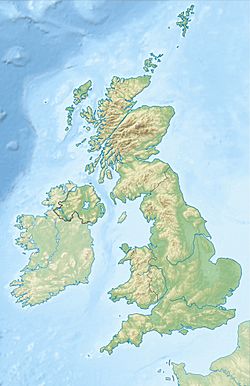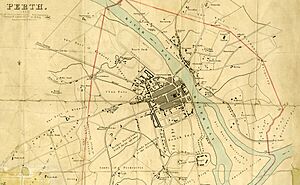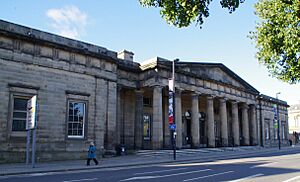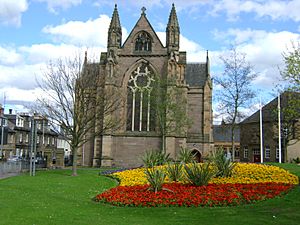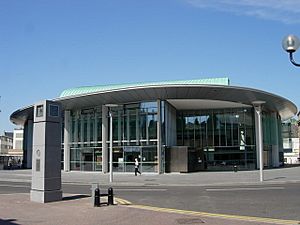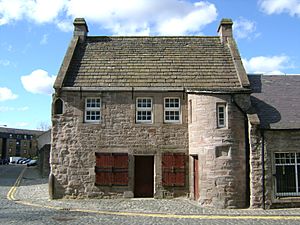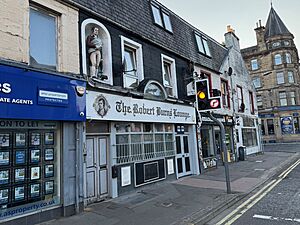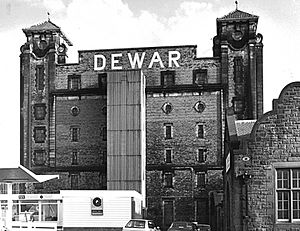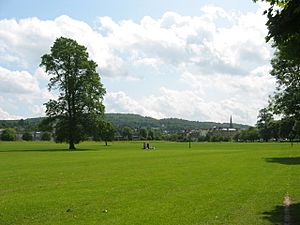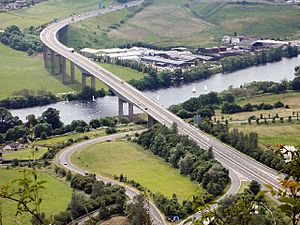Perth, Scotland facts for kids
Quick facts for kids
Perth
Peairt (Scottish Gaelic)
|
||
|---|---|---|
|
Skyline of Perth's Tay Street
St John's Kirk
Fair Maid's House
|
||
|
||
| Lua error in Module:Location_map at line 420: attempt to index field 'wikibase' (a nil value).
Location within Perth and Kinross
|
||
| Sovereign state | United Kingdom | |
| Country | Scotland | |
| Council area | Perth and Kinross | |
| Lieutenancy area | Perth and Kinross | |
| Area | ||
| • Locality | 6.8 sq mi (17.5 km2) | |
| • Urban | 6.8 sq mi (17.5 km2) | |
| Population
(2020)
|
||
| • Locality | 47,350 | |
| • Density | 7,008/sq mi (2,706/km2) | |
| • Language(s) | English Scots |
|
| Time zone | UTC±0 (Greenwich Mean Time) | |
| • Summer (DST) | UTC+1 (British Summer Time) | |
| Postcode areas | ||
| Area code(s) | 01738 | |
| OS grid reference | NO115235 | |
| Airport | Perth Airport (PSL) | |
| Railway station | Perth railway station | |
Perth is a city in Scotland, located right on the River Tay. It's the main town for the Perth and Kinross area and used to be the historic county town of Perthshire. In 2018, about 47,430 people lived here.
People have lived in Perth since ancient times. It's built on a small hill, safe from the river's floods. Long ago, Mesolithic hunter-gatherers lived here. Later, Neolithic farmers built standing stones around 4,000 BC. Near Perth is Scone Abbey, where Scottish kings were traditionally crowned on the Stone of Scone. This made Perth very important, often called a "capital" because the royal court stayed there a lot.
King William the Lion made Perth a Royal burgh in the early 1100s. This meant it was a special town with rights to trade. Perth became one of Scotland's richest towns, trading with countries like France and the Low Countries. They imported fancy goods like Spanish silk and French wine.
The Scottish Reformation in 1559 changed Perth a lot. After a speech by John Knox at St John's Kirk, people destroyed parts of the churches. Perth was also taken over by Jacobite supporters three times in the 1600s and 1700s. In 1760, Perth Academy was founded, which helped bring new industries like making linen, leather, and whisky. When railways arrived, Perth became a key transport hub, with its first station built in 1848.
Perth is known as "The Fair City" because of a book called Fair Maid of Perth by Sir Walter Scott in 1828. People also used to call it "St John's Toun" after its main church, St John the Baptist. This name is still used by the city's football team, St Johnstone F.C.. Perth is also called the "Gateway to the Highlands" because of its location.
Today, Perth is a busy shopping area for the towns around it. In 2018, it was even named "Scotland's Food Town." The city's economy has grown, especially in the insurance and banking industries, after the local whisky industry became smaller.
Contents
- What's in a Name? The Story of Perth's Name
- Perth's Past: A Look at History
- How Perth is Governed
- Who Lives in Perth? Population Facts
- Perth's Location and Weather
- Perth's Economy: How People Make a Living
- Culture and Fun in Perth
- Learning in Perth: Schools and Colleges
- Getting Around Perth: Transport
- Famous People from Perth
- Freedom of the City
- See also
What's in a Name? The Story of Perth's Name
The name "Perth" comes from an old Pictish word meaning "wood" or "small forest." It's similar to the Welsh word "perth," which means "hedge" or "thicket."
For a long time in the Middle Ages, people who spoke Scots called the city "St John's Toun" or "Saint Johnstoun." This was because the main church in the town was dedicated to St John the Baptist. Until the mid-1600s, "Perth" referred to the wider area, and the town itself was "St John's ton." Then, the wider area became "Perth Shyre" (Perthshire), and "St John's ton" became known as Perth.
The old Pictish name and some archaeological finds suggest that people lived here very early on. It was likely a good spot because it had river crossings and a slightly raised area on the west bank of the River Tay, which helped protect it from floods. Discoveries show that Mesolithic hunter-gatherers were here over 8,000 years ago. Later, Neolithic standing stones and circles appeared around 4,000 BC, after farming began. A very old Bronze Age log boat, about 1,000 BC, was found in the River Tay mudflats nearby.
Perth's Past: A Look at History
Early Days of Perth
Perth started with two main streets, High Street and South Street. These were connected by small lanes called "vennels." Many of these vennels are named after old trades, like Cow Vennel and Fleshers' Vennel (where butchers worked).
The nearby town of Scone, just 3 km away, was a major royal center for the Kingdom of Alba. This made Perth very important early on. Perth was seen as the capital of Scotland because the royal court often stayed there. King William the Lion officially made Perth a Royal burgh in the early 1100s.
During the 1100s and 1200s, Perth was one of the richest trading towns in Scotland. Many skilled workers, like Hammermen (metalworkers) and Glovers (glove makers), lived here. Perth traded a lot with France, the Low Countries, and the Baltic Countries. They brought back luxury items like Spanish silk and French pottery and wine.
The royal castle in Perth was destroyed by a flood in 1209 and was never rebuilt. At that time, Perth was protected by some walls and a clever water system called Perth Lade.
In 1296, King Edward I of England attacked Perth. Since the city had only a ditch for defense, it fell quickly. The English then built stronger defenses. In 1336, Edward III made six monasteries pay for stone walls, towers, and gates around the city. These were the strongest defenses of any Scottish city in the Middle Ages. You can still see a small part of the old wall in Albert Close today.
From the 1400s to the 1800s
In 1437, King James I of Scotland was killed in Perth at the Blackfriars church.
In May 1559, John Knox gave a famous speech at St John's Kirk. This led to people destroying altars and attacking churches, starting the Scottish Reformation in the area. Perth was also affected by the Jacobite uprisings. The city was taken over by Jacobite soldiers in 1689, 1715, and 1745.
In 1760, Perth Academy was founded. This helped bring major industries to the city, which then had about 15,000 people. Making linen, leather, bleach, and whisky were the main businesses. Perth's location made it perfect for becoming a key transport center when railways arrived. The first railway station was built in 1848. Horse-drawn carriages were popular in the 1890s, but soon electric trams took their place.
Perth in Modern Times
Perth changed a lot during the First World War, with new industries and social developments. In 1829, a new settlement in Western Australia was named Perth after the birthplace of Sir George Murray. The old Municipal Buildings were finished in 1881.
Today, Perth is a big shopping center for the area. It has a main shopping mall, St John's Centre, and a pedestrianized high street with many unique shops. The city also has many pubs. Major employers in Perth include Aviva, Royal Bank of Scotland, and Scottish and Southern Energy. The international transport company Stagecoach Group also has its main office here.
How Perth is Governed
Who Represents Perth?
Perth is part of the Perth and Kinross-shire area, which elects one MP to the UK Parliament. Currently, Pete Wishart from the Scottish National Party (SNP) is the MP.
For the Scottish Parliament, Perth is split into two areas: Perthshire North and Perthshire South and Kinross-shire. These areas elect MSPs. John Swinney (SNP) represents Perthshire North, and Jim Fairlie (SNP) represents Perthshire South and Kinross-shire.
Perth's Legal System
Perth's Sheriff Court is a very old and important building on Tay Street. It was built in 1819 and stands where Gowrie House used to be.
Becoming a City Again
For a while, Perth was not officially called a "city" by the UK government, even though road signs still used the term. In 2007, Alex Salmond, Scotland's First Minister at the time, supported a campaign to get city status back for Perth. The local council, Perth and Kinross, hoped that the city's 800th anniversary in 2009 would help.
Perth was one of 26 places that applied for city status to celebrate the Queen's Diamond Jubilee in 2012. On March 14, 2012, Perth successfully got its city status back, becoming Scotland's seventh city. The Queen visited Perth on July 6, 2012, as part of her Jubilee tour.
Perth's Coat of Arms
The coat of arms for Perth has a red shield with a silver Paschal lamb. The lamb has a gold halo and holds a flagpole with a blue banner that has a silver saltire (like the Scottish flag). All of this is inside a special border. The shield is held up by a double-headed eagle, and the motto is Pro Lege Rege et Grege, which means "For the Law, King and People" in Latin.
This coat of arms has been used since at least the 1300s. The red and silver colors are for John the Baptist, who is the town's patron saint, and the lamb is his symbol. The double-headed eagle might refer to an old Roman settlement called "Bertha" near Perth.
Who Lives in Perth? Population Facts
Perth's Population Over Time
In 1891, Perth had 30,768 people. By 1901, it grew to 32,872.
| Perth | Perth & Kinross | Scotland | |
|---|---|---|---|
| Total population | 43,450 | 97,824 | 5,062,011 |
| Foreign born | 3.06% | 3.57% | 3.35% |
| Over 75 years old | 8.16% | 8.56% | 7.09% |
| Unemployed | 1,045 | 2,730 | 148,082 |
According to the 2001 UK Census, Perth's population was 43,450. In 2008, it was estimated to be 44,820. The age groups in Perth are similar to the rest of Scotland. The largest group is people aged 30 to 44 (22%). The average age for males in Perth was 37, and for females, it was 40.
Most residents (95.42%) were born in the United Kingdom, with 87.80% from Scotland. A smaller number were born in other European Union countries (1.18%) or elsewhere in the world (1.88%).
Religion in Perth

Christianity is the most common religion in Perth. In the 2011 census, over half the people in the Perth and Kinross area said they were Christian. The most popular Christian group is the Church of Scotland, which has nine churches in the city, including the large St John's Kirk.
The Roman Catholic Church is the second most popular Christian group, with three churches in Perth. There's also St Mary's Monastery on the edge of the city. The Scottish Episcopal Church has two churches in Perth: St Ninian's Cathedral and Church of St. John the Baptist.
Other Christian churches in Perth include the Methodist Church, Elim Pentecostal Church, and the Salvation Army. There's also a Quaker community and a Church of Jesus Christ of Latter-day Saints.
The Islamic community in Perth meets at a mosque on Glasgow Road.
The number of people following these religions is decreasing. In the 2011 census, almost 40% of people said they didn't belong to any religion.
- Some of Perth's Churches and Places of Worship
- St John's Kirk, St John's Place (Church of Scotland)
- St Matthew's Church, Tay Street (Church of Scotland)
- Kinnoull Parish Church, Dundee Road (Church of Scotland)
- St Ninian's Cathedral, Atholl Street (Episcopal)
- St John the Baptist Roman Catholic Church, Melville Street (Roman Catholic)
- Perth Mosque, Glasgow Road (Islam)
Perth's Location and Weather
Perth is in a flat, fertile area, but it's surrounded by hills.
- Hills near Perth
- Kinnoull Hill – about 2.4 km away, 222 meters high
- Moncreiffe Hill – about 4.3 km away, 223 meters high
- Friarton Hill – about 2.7 km away, 92 meters high
Perth has an oceanic climate, which means it has cool summers and mild winters. The nearest weather station is at Strathallan, about 8 km from the city center. Temperatures have ranged from -18.6°C in January 1963 to 32.0°C in July 2022. On average, the warmest day reaches about 27°C.
| Climate data for Perth (23 m asl, averages 1991–2020, extremes 1960–present) | |||||||||||||
|---|---|---|---|---|---|---|---|---|---|---|---|---|---|
| Month | Jan | Feb | Mar | Apr | May | Jun | Jul | Aug | Sep | Oct | Nov | Dec | Year |
| Record high °C (°F) | 14.8 (58.6) |
15.9 (60.6) |
21.4 (70.5) |
23.9 (75.0) |
28.1 (82.6) |
31.1 (88.0) |
32.0 (89.6) |
30.3 (86.5) |
28.6 (83.5) |
24.0 (75.2) |
17.7 (63.9) |
15.4 (59.7) |
32.0 (89.6) |
| Mean daily maximum °C (°F) | 7.1 (44.8) |
7.7 (45.9) |
9.5 (49.1) |
12.7 (54.9) |
15.8 (60.4) |
18.4 (65.1) |
20.1 (68.2) |
19.4 (66.9) |
16.9 (62.4) |
13.1 (55.6) |
9.4 (48.9) |
7.1 (44.8) |
13.1 (55.6) |
| Daily mean °C (°F) | 4.0 (39.2) |
4.5 (40.1) |
5.9 (42.6) |
8.4 (47.1) |
11.1 (52.0) |
13.9 (57.0) |
15.7 (60.3) |
15.2 (59.4) |
12.9 (55.2) |
9.2 (48.6) |
6.1 (43.0) |
3.8 (38.8) |
9.2 (48.6) |
| Mean daily minimum °C (°F) | 0.8 (33.4) |
1.2 (34.2) |
2.3 (36.1) |
4.0 (39.2) |
6.3 (43.3) |
9.4 (48.9) |
11.2 (52.2) |
11.0 (51.8) |
8.8 (47.8) |
5.7 (42.3) |
2.8 (37.0) |
0.5 (32.9) |
5.3 (41.5) |
| Record low °C (°F) | −18.6 (−1.5) |
−15.1 (4.8) |
−11.9 (10.6) |
−5.3 (22.5) |
−3.7 (25.3) |
−1.1 (30.0) |
3.2 (37.8) |
2.9 (37.2) |
−3.6 (25.5) |
−6.5 (20.3) |
−10.2 (13.6) |
−17.8 (0.0) |
−18.6 (−1.5) |
| Average precipitation mm (inches) | 80.1 (3.15) |
92 (3.6) |
52.9 (2.08) |
47.9 (1.89) |
50.9 (2.00) |
67.7 (2.67) |
65.3 (2.57) |
75.6 (2.98) |
59.8 (2.35) |
97.2 (3.83) |
88.1 (3.47) |
88.3 (3.48) |
865 (34.1) |
| Mean monthly sunshine hours | 43.3 | 70.3 | 114.4 | 164.1 | 188.3 | 159.8 | 172.8 | 154.6 | 122.5 | 83 | 61.7 | 35.3 | 1,370 |
| Source 1: Weatherbase | |||||||||||||
| Source 2: Met Office | |||||||||||||
Perth's Economy: How People Make a Living
Perth's economy is strong because it's very diverse. It has a mix of large companies, public sector jobs, and many small and medium-sized businesses. New jobs are appearing in renewable energy, insurance, manufacturing, and transport.
The biggest employer in Perth is the Perth and Kinross Council, with 6,000 employees. Other major employers include NHS Tayside, SSE plc, and Perth College UHI. The big international transport company Stagecoach Group also has its main office in Perth.
Perth's city center is west of the River Tay. The main shopping area is on the pedestrianized High Street. You'll find big stores there, as well as many unique local shops on streets like George Street. In 2010, the High Street was improved with new seating and lighting. There's also a retail park outside the city center with more shops.
Before the economic downturn, Perth's economy was growing faster than the Scottish average. Even though growth has slowed, it's still doing better than many other places in Scotland. Perth is ranked in the top 10 for new businesses in Scotland.
Culture and Fun in Perth
The Perth Museum and Art Gallery, on George Street, is one of Scotland's oldest museums outside of major cities. Another museum, the Fergusson Gallery, is in the old Perth Water Works building on Tay Street. It holds a large collection of art by John Duncan Fergusson.
Perth Theatre opened in 1900. It recently had a big renovation to add new spaces for youth theatre and performances. Perth Concert Hall opened in 2005.
Perth City Hall has hosted many concerts and events. It's currently being turned into a new heritage and arts attraction.
The new-wave band Fiction Factory started in Perth. They had a hit song called "(Feels Like) Heaven" in 1984.
The Perth Festival of the Arts is an annual event in May, featuring art, theatre, opera, and classical music. In recent years, it has also included comedy and popular music.
Perth has several twin cities around the world, including Perth in Australia and Perth in Canada.
Famous Landmarks and Tourist Spots
St John's Kirk, on St John's Place, is one of Perth's most important buildings. The original church dates back to the mid-1100s. Most of the current church was built between 1440 and 1500. Its tower and spire are still a key part of Perth's skyline. Inside, there's a rare 15th-century brass chandelier from the Low Countries.
Another important building is the former King James VI Hospital, built in 1750. The spire of St Paul's Church, finished in 1807, is also a notable landmark. Pullar House on Mill Street used to be a large dyeworks and is now council offices.
The Fair Maid's House, in North Port, is the oldest surviving house in Perth. Parts of it date back to 1475. It was the home of Catherine Glover in Sir Walter Scott's novel The Fair Maid of Perth.
A small statue of the poet Robert Burns can be seen above the Robert Burns Lounge Bar. The nearby City Mills, built on the Perth Lade, were once busy with industry. The Lower City Mills (1805) and Upper Mills (1792) are still standing.
Protecting Perth's Heritage
After Perth became a city again in 2012, the Perth and Kinross Heritage Trust started the Perth City Heritage Fund (PCHF). This fund helps owners of historic buildings in Perth repair and renovate them with grants. This project is funded by the Scottish Government.
Media in Perth
Perth's local newspaper is the Perthshire Advertiser.
For TV, signals come from the Angus TV transmitter.
Hospital Radio Perth broadcasts to Perth Royal Infirmary and Murray Royal Hospital. It has won "British Station of the Year" multiple times. Perth also receives national radio stations like BBC Radio Scotland.
Sports and Recreation in Perth
St Johnstone is Perth's professional football club. They play in the Scottish Premiership at McDiarmid Park. They won the Scottish Cup for the first time in 2014. There are also two other local football clubs: Jeanfield Swifts and Kinnoull.
The senior rugby team, Perthshire RFC, plays on the North Inch.
On the western side of the North Inch is Bell's Sports Centre, which used to be the largest domed building in Britain.
Perth Leisure Pool, near the railway station, is the city's swimming center. Next to it is the Dewar's Centre, which has an eight-lane ice rink. This center is very important for curling in Scotland, hosting many competitions.
Perth hosts Scotland's largest volleyball event every May, the Scottish Open Volleyball Tournament.
Parks and Gardens in Perth
Perth has two main parks, the North Inch and South Inch. The word "Inch" comes from a Gaelic word meaning island or meadow. These parks were given to the city in 1377 by King Robert III.
The North Inch is just north of the city center, bordered by Charlotte Street and Atholl Street. The River Tay is to its east. There's a path around the park and a golf course.
The South Inch is about 0.8 km south of the North Inch, across the city center. The Inches are connected by Tay Street, which runs along the Tay. The South Inch offers activities like bowling, an adventure playground, and a skate park. The Perth Show is held here every year.
Another park, Norie-Miller Walk, is located across the Tay.
- Gardens in Perth
- Branklyn Garden
- Rodney Gardens
Learning in Perth: Schools and Colleges
Perth has many primary schools. For secondary education, there are:
- Perth Academy
- Perth Grammar School
- Perth High School
- St John's Academy
- Bertha Park High School
For further and higher education, including university degrees, students can go to Perth College UHI. This is one of the largest partners in the University of the Highlands and Islands. It also owns AST (Air Service Training), which teaches aircraft engineering.
Getting Around Perth: Transport
Road Travel
Perth is a key transport hub for road and rail travel across Scotland. The M90 motorway goes south from Perth to Edinburgh. The A9 road connects Perth to Stirling and Glasgow in the southwest, and Inverness in the north. Other important roads include the A85 to Crieff, and the A90 to Dundee and Aberdeen.
The city itself was bypassed by the M90 in the 1970s and the A9 in 1986. The M90, A9, and A93 roads all meet at Broxden Junction, which is one of Scotland's busiest road junctions. From here, you can see signs for all seven of Scotland's cities. The M90's final part included building the Friarton Bridge in 1978, which helped remove traffic from the city center. This bridge is the most northern motorway bridge in the UK.
There are four bridges that cross the River Tay in Perth:
- Smeaton's Bridge (also called Perth Bridge or the Old Bridge): Built in 1771, it carries traffic for West Bridge Street.
- Queen's Bridge: Finished in 1960, it replaced the old Victoria Bridge. Queen Elizabeth II opened it.
- Tay Viaduct: A railway bridge completed in 1863, carrying trains to and from the railway station.
- Friarton Bridge: The southernmost bridge, part of the M90 motorway.
Train Travel
Perth railway station has regular train services to Fife and Edinburgh, east to Dundee and Aberdeen, south to Stirling and Glasgow, and north to Inverness.
There are also two direct trains per day to London: the Highland Chieftain to King's Cross and the Caledonian Sleeper (an overnight train) to Euston.
Bus Travel
Local buses in Perth are run by Stagecoach East Scotland. For longer journeys, you can take inter-city buses from Leonard Street bus station to most major places in Scotland. The budget Megabus service is based at Broxden Junction, just outside the city center, and has direct buses to Scotland's biggest cities, plus Manchester and London. There's also a park and ride service from Broxden to the city center.
Air Travel
Perth has a small airport, Perth Airport, located at New Scone, about 6 km northeast of the city. It's used for private planes and pilot training, not commercial flights. The closest major commercial airports are Edinburgh Airport, Glasgow Airport, and Aberdeen Airport. Dundee Airport, which is 12 km away, also has flights, mainly by Loganair.
Famous People from Perth
Many notable people have connections to Perth:
- William of Perth (1100s): A Scottish saint.
- John Row (c. 1526–1580): A reformer during the Scottish Reformation.
- Sir George Murray (1772–1846): A politician and army officer. The city of Perth, Australia was named after his birthplace.
- David Octavius Hill (1802–1870): A painter and photography pioneer.
- Effie Gray (1828–1897): An artist's model.
- John Buchan (1875–1940): Author of The Thirty-Nine Steps and former Governor General of Canada.
- William Soutar (1898–1943): A poet.
- Ann Gloag (b. 1942) and Brian Souter (b. 1954): Co-founders of Stagecoach Group.
- Fred MacAulay (b. 1956): A comedian.
- Ewan McGregor (b. 1971): A famous actor.
- Christopher Bowes: Musician from the bands Alestorm and Gloryhammer.
- Sports Stars
- Bobby Moncur: Scotland and Newcastle United football captain.
- David Wotherspoon: Football player for St Johnstone.
- Elena Baltacha: Tennis player.
- Matt Fagerson: Professional rugby player.
- Zander Fagerson: Professional rugby player, brother of Matt.
- Chloe Grant: Racing driver.
- Stevie May: Professional football player.
- Scott Donaldson: Professional snooker player.
- Eilidh Doyle: Olympic athlete.
- Lisa Evans: Professional football player.
- Eve Muirhead: Curler, Olympic gold medallist.
- Mili Smith: Curler, Olympic gold medallist.
Freedom of the City
The "Freedom of the City" is a special honor given to people, military units, or groups. Here are some who have received it in Perth:
- Individuals
- John Buchan: 1933
- Sir Francis Norie-Miller: 1933
- Duke of York: 1935
- Duchess of York: 1935
- Sir Winston Churchill: 1947
- Duke of Edinburgh: 2012
- Military Units
- The Black Watch (Royal Highland Regiment): 1947
- The Royal British Legion (Scotland): 2004
- Organizations
See also
 In Spanish: Perth (Escocia) para niños
In Spanish: Perth (Escocia) para niños


